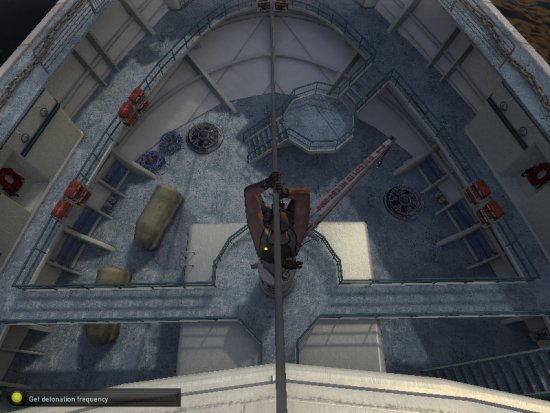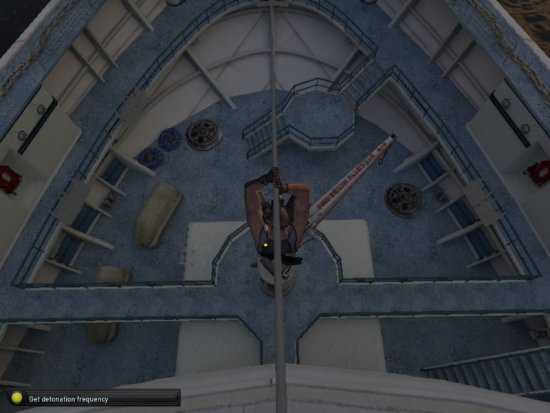Splinter Cell: Double Agent: A Performance Analysis
by Josh Venning on December 8, 2006 2:10 AM EST- Posted in
- GPUs
Settings
We tested Double Agent at two major settings; the first we refer to as high quality, and the other we will call medium quality (though the game doesn't have specific settings that correspond with this). With high quality settings, all the graphics settings are set to "on" and/or to their highest quality level (with the exception of AA and HDR which are mutually exclusive on cards that don't support floating point with AA, such as the GeForce 7 series).

We found that the settings which had some of the largest impacts on performance with Splinter Cell: Double Agent were the different shadow settings, specifically high quality soft shadows and high detail shader. By turning off these effects as well as trilinear filtering, we were able to significantly improve performance, making the game much more playable on lower-end hardware.

We chose these settings for our lower quality tests both because of the improved performance they offer while still allowing for some great visuals. Certain settings like high detail environments and high detail shader might offer better performance when switched to low or off, but we found the sacrifice in graphical quality too great to justify anything but "high" for these options. Luckily, the game isn't the most graphically intensive game out right now, and it happens to run well at highest quality on a wide variety of cards, particularly with ATI hardware.
Without the shadow effects enabled, the game does look a bit less striking, but the performance gains we see with these settings off is a good trade-off, especially for lower end hardware. Also, there is almost no difference visually with these settings on or off in our first benchmark because it takes place at night, and this will be the case for many areas in the game. Of course, if you have a card that can handle the extra stress, the complex shadow effects make levels like the cruise ship look much more stunning.


As we mentioned, because there is no timedemo function like with the previous Splinter Cell: Chaos Theory, we had to use FRAPS to record the frame rate for both of our benchmarks. Even though we used FRAPS rather than a timedemo to record our average frame rates during these scenes, our results were fairly consistent between multiple runs. To be as accurate as possible, we also ran each benchmark multiple times and took the mean result.
We tested Double Agent at two major settings; the first we refer to as high quality, and the other we will call medium quality (though the game doesn't have specific settings that correspond with this). With high quality settings, all the graphics settings are set to "on" and/or to their highest quality level (with the exception of AA and HDR which are mutually exclusive on cards that don't support floating point with AA, such as the GeForce 7 series).

We found that the settings which had some of the largest impacts on performance with Splinter Cell: Double Agent were the different shadow settings, specifically high quality soft shadows and high detail shader. By turning off these effects as well as trilinear filtering, we were able to significantly improve performance, making the game much more playable on lower-end hardware.

We chose these settings for our lower quality tests both because of the improved performance they offer while still allowing for some great visuals. Certain settings like high detail environments and high detail shader might offer better performance when switched to low or off, but we found the sacrifice in graphical quality too great to justify anything but "high" for these options. Luckily, the game isn't the most graphically intensive game out right now, and it happens to run well at highest quality on a wide variety of cards, particularly with ATI hardware.
Without the shadow effects enabled, the game does look a bit less striking, but the performance gains we see with these settings off is a good trade-off, especially for lower end hardware. Also, there is almost no difference visually with these settings on or off in our first benchmark because it takes place at night, and this will be the case for many areas in the game. Of course, if you have a card that can handle the extra stress, the complex shadow effects make levels like the cruise ship look much more stunning.


As we mentioned, because there is no timedemo function like with the previous Splinter Cell: Chaos Theory, we had to use FRAPS to record the frame rate for both of our benchmarks. Even though we used FRAPS rather than a timedemo to record our average frame rates during these scenes, our results were fairly consistent between multiple runs. To be as accurate as possible, we also ran each benchmark multiple times and took the mean result.










28 Comments
View All Comments
mpc7488 - Friday, December 8, 2006 - link
Neverwinter Nights 2 would be my vote. From the reviews I've read and my experience, it's even more difficult to run than Oblivion (though it's not clear why, the graphics are not that great in most instances, though the lighting effects are phenominal).Centurin - Friday, December 8, 2006 - link
Neverwinter Nights 2 has framerate problems because of the engine. I wouldn't really use it to benchmark future games. I still feel that Oblivion is the best benchmarks for graphics at this point.DukeN - Friday, December 8, 2006 - link
Where are the 8800 series benchmarks?Josh Venning - Friday, December 8, 2006 - link
As we mentioned in the article, the 8800 cards weren't rendering the game properly. The graphical errors with Double Agent on the 8800 GTS and GTX made the game basically impossible to play. That's why we didn't include numbers for these cards. Hopefully when a patch or driver update fixes this issue we can see how the game performs on the 8800 in the future.Jodiuh - Friday, December 8, 2006 - link
97.44 on NV's site now...Splinter Cell: Double Agent Single Player has geometry corruption.
Jodiuh - Friday, December 8, 2006 - link
^^ That's under issue resolved.PrinceGaz - Friday, December 8, 2006 - link
The GeForce 6 series cards support SM3.0 so could you please add results for some representative cards of that generation. I would suggest a 6800GT (which usually performs in between a 7600GS and 7600GT so would probably belong in the 'mid-range' category) and a 6600GT (which I guess is somewhere around the 7300GT level or slightly higher and would therefore be considered 'low-end').I know the GF6 cards are getting on a bit now but there are a lot of people still using them as they are still capable of running most games quite well (especially the 6800s), and including them makes sense as owners of them are probably the most likely to be considering an upgrade which is what an article like this is presumably intended for.
imaheadcase - Friday, December 8, 2006 - link
From the performance I'm assuming it looks better when playing, because that looks like a console game graphics. heheshabby - Friday, December 8, 2006 - link
The only thing this article is missing is different cpu's, but let me fill that void. With a p4 @ 3.2 ghz + x1900xtx i get around 10-20fps avg. Luckily my e6400 just arrive and i will finally get some decent fps now since the p4 seems like a huge bottleneck.yyrkoon - Friday, December 8, 2006 - link
Forcing paying customers to BETA test games, seems to be becoming a habit among developers, and is simply wrong. Anyone remember the BC 3000 A.D. days and what happened to Derrik Smart ? Anyhow, hoping that Bethesda made Oblivion into a game that would renew my days of playing Daggerfall, I purchased the game, and even stuck up for the developers when others criticized the bugs of the game. Days turned into weeks, then weeks into months, additional content was released (pay ware I might add), all before Bethesda finally released its beta patch. It soon dawned on me, that Bethesda no longer enjoyed creating games, or cared about making their customers happy, but only cared about making money, and that I couldn't help feeling ripped off.I do realize that game developers need to make money like anyone else, but they also need to realize that "anyone else" that works very hard for their money, when they do sell something, they need to provide a solid, working product. Could you imagine Ford, or another car manufacturer selling cars, as new, only to let the customer know AFTER they made the purchase, that some items still needed to be worked on, and that some assembly may be required ? We all know this wouldn't float for one second. After all, its not our fault the developer couldn't release a product on time, or needs money NOW to continue their product. Also, I find it rather strange, that a game recently released does not support new hardware, when games that have been out much longer do. Or did they ?
Companies such as this will find it very hard to get any of my money in the future, and I can only hope that other people will follow, and that perhaps someday we'll have game companies that actually release games as advertised once again. It's hard enough that we gamers have to live with games that are no longer as dynamic as they once were, and have to pay $50usd for game content that lasts about 5-8 hours, before you start reliving the game over, and over, until it finally ends.